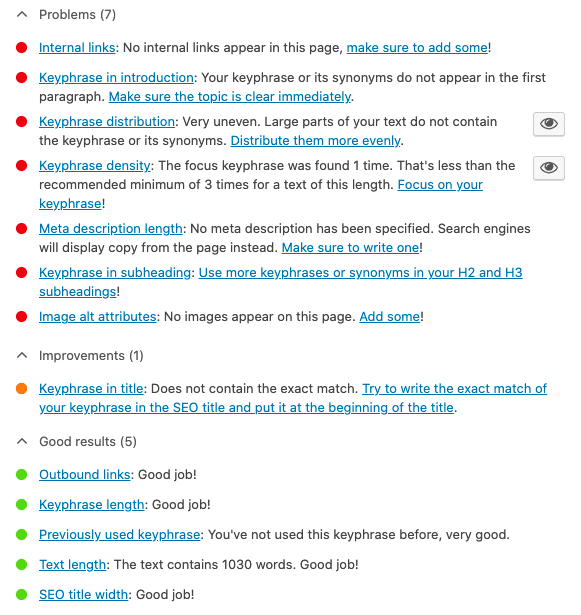You’ve put time and money into your SEO campaign, but how do you know whether all that effort is making a positive impact on your business?
In this post, I’ll outline the top 5 metrics you need to understand when it comes to measuring the success of an SEO campaign.
1. Keyword Rankings
Each individual page on your website should be laser targeted to rank for a handful of keywords. The main focus will be on your primary keyword (usually the keyword that has the largest amount of search volume) and a handful of secondary keywords.
These keywords should be closely related to the content of the page as well as the overall website.
You should be regularly tracking your keyword rankings in any of the rank checking tools available online (including software such as RankTracker by Link Assistant) and note any movement on keyword ranking positions.
By tracking your keyword ranking you can assess whether your efforts are working and you can tweak things if you aren't noticing any change in your ranking. You may even need to change your primary keyword if there are just too many other sites trying to rank for it.
Improvements in rankings will lead to an increase in website traffic over time.
2. Organic Traffic
Organic traffic is traffic that comes to your website from search engines such as Google. Typically, a web surfer would type a query into a search engine and click on the result (website link) displayed to them in the organic listings.
People clicking onto your website from these listings are considered organic traffic because you didn't pay for advertising to get that click. Therefore, the more traffic (from relevant keywords) you can generate, the better.
You can increase your organic traffic in several ways:
- Improving your rankings: Increasing your rankings will increase your visibility on Google. The more eyeballs you have finding your organic listing on Google, the better chance you have of increasing your traffic. If you're not sure where you can improve then a good start is to conduct an SEO audit.
- Improving meta titles and descriptions: The meta title and description are the pieces of information that are shown on the Google results page. Crafting a more compelling title and description will entice a larger percentage of people to click on your link and visit your website
- Improving current content on your website. Improving your current content for pages that don’t rank at the top of the search engines will help to increase your rankings, which will then increase your organic traffic. To improve the content you can use a tool such as Yoast (if you use WordPress) to check that you have added your keywords evenly throughout your content and give you pointers such as this:

3. Conversion Rate
Conversion rate is the percentage of people that visit your website and perform a desired action compared to the overall number of people that visit your website.
It is calculated by dividing your number of conversions by your number of visitors.
Once you’ve found your conversion rate, how do you know whether it’s at an acceptable level?
Online conversion rates can vary dramatically across industries. But aim to have a conversion rate around 3%-3.5%. Anything below 1% would require you to review your conversion factors and potentially call in experts to help remedy the problem.
Time and time again we’ve seen organic traffic convert better than paid traffic sources such as Pay Per Click (PPC) and Facebook ads. This is based on data we’ve seen from our clients.
Your SEO should be driving organic traffic to your website, while your website itself needs to be optimised to convert that traffic into qualified leads.
4. Clicks for Relevant Search Queries
One of the best ways to find out if your SEO work is delivering results is to look into the keywords that are generating traffic for your website.
The easiest way to do this is to look at Google Search Console.
You can access your GSC by going to search.google.com/search-console.
From there, click on ‘performance’ and select the date, click ‘compare’ and choose the option ‘compare last 28 days to previous period’.
This date range filter will allow you to compare the amount of traffic coming from specific keywords for a 28-day period vs the previous 28-day period. It’s a great way to measure steady growth for your most important keywords over time.
You can also play around with different date ranges, to compare months or weeks to the previous year.
5. Bounce Rate
Bounce rate is the percentage of traffic that leaves your website just after landing on it, and don’t view any other pages on your website.
You can think of it as someone clicking the ‘back’ arrow or closing a tab straight after your page loads.
Bounce rate is an indication of how relevant a web visitor thinks the page they land on is to them.
You can improve your bounce rate by ensuring that:
- Your website loads fast. Your SEO audit will identify which pages are loading slowly. You might need to optimise your images and there are plenty of tools around to help you with that.
- The page is designed well and is visually eye-catching. You could try split testing different designs.
- The query that they searched and the page they landed on are congruent. Making sure that you use the same design and the same messaging. Confusion = abandonment.
Ideally, you want to have your bounce rate as low as possible. Different types of pages have different bounce rates, for instance, your homepage or service pages should be lower than blog posts and pages.
If you have:
- A less than 30% bounce rate is considered good.
- 31%-60% – this is the average; you should review pages that have a high bounce rate to see how you can improve them.
- 70%+ – this requires attention. Consider reviewing your homepage and highest bounce rate pages to see what improvements can be made. You can also look at high-ranking competitor websites and ensure you have similar content and website structure to them.
And there you have it! These 5 metrics will give you the insight required to measure and improve your SEO strategy over time.







